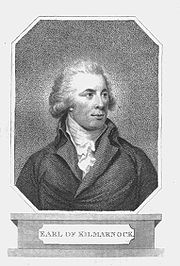
William Boyd, 4th Earl of Kilmarnock
Encyclopedia

Earl of Kilmarnock
The title Earl of Kilmarnock was created in the peerage of Scotland in 1661 for William Boyd, 10th Lord Boyd. That title was also created in the Scottish peerage in 1454 for Robert Boyd, Great Chamberlain of Scotland...
, was a Scottish
Scotland
Scotland is a country that is part of the United Kingdom. Occupying the northern third of the island of Great Britain, it shares a border with England to the south and is bounded by the North Sea to the east, the Atlantic Ocean to the north and west, and the North Channel and Irish Sea to the...
nobleman.
William Boyd was educated at Glasgow
Glasgow
Glasgow is the largest city in Scotland and third most populous in the United Kingdom. The city is situated on the River Clyde in the country's west central lowlands...
. Like his father in the rebellion
Jacobite rising
The Jacobite Risings were a series of uprisings, rebellions, and wars in Great Britain and Ireland occurring between 1688 and 1746. The uprisings were aimed at returning James VII of Scotland and II of England, and later his descendants of the House of Stuart, to the throne after he was deposed by...
of 1715, William initially supported the Government side, but in the rebellion of 1745, owing either to a personal affront or to the influence of his wife or to his straitened circumstances he deserted George II and joined Charles Edward Stuart
Charles Edward Stuart
Prince Charles Edward Louis John Casimir Sylvester Severino Maria Stuart commonly known as Bonnie Prince Charlie or The Young Pretender was the second Jacobite pretender to the thrones of Great Britain , and Ireland...
, the Young Pretender.
Made a Privy Counsellor to Charles, he was appointed a colonel of guards and subsequently a general. He fought at Falkirk
Battle of Falkirk (1746)
During the Second Jacobite Rising, the Battle of Falkirk Muir was the last noteworthy Jacobite success.-Background:...
and Culloden
Battle of Culloden
The Battle of Culloden was the final confrontation of the 1745 Jacobite Rising. Taking place on 16 April 1746, the battle pitted the Jacobite forces of Charles Edward Stuart against an army commanded by William Augustus, Duke of Cumberland, loyal to the British government...
, where he was taken prisoner, and was beheaded on Tower Hill on 18 August 1746.
Before his execution, he wrote to a friend from prison about his indebtedness to the shoemakers of Elgin
"Beside my personal debts mentioned in general and particular in the State, there is one for which I am liable in justice, if it is not paid, owing to poor people who gave their work for it by my orders. It was at Elgin in Murray, the Regiment I commanded wanted shoes. I commissioned something about seventy pair of shoes and brogues, which might come to 3 shillngs or three shillings and sixpence each, one with the other. The magistrates divided them among the shoemakers of the town and country, and each shoemaker furnished his proportion. I drew on the town, for the price, out of the composition laid on them, but I was afterwards told at Inverness that, it was believed, the composition was otherwise applied, and the poor shoemakers not paid. As these poor people wrought by my orders, it will be a great ease to my heart to think they are not to lose by me, as too many have done in the course of that year, but had I lived I might have made some inquiry after: but now it is impossible, as their hardships in loss of horses and such things, which happeened through my soldiers, are so interwoven with what was done by other people, that it would be very hard, if not impossible, to separate them. If you'll write to Mr Innes of Dalkinty at Elgin (with whom I was quartered when I lay there), he will send you an account of the shoes, and if they were paid to the shoemakers or no; and if they are not, I beg you'll get my wife, or my successors to pay them when they can......"
On his coffin was a plate with the inscription, "Gulielmus. Comes. de Kilmarnock decollatus, 18 Augusti, 1746, Ætat. suæ 42," with an earl's coronet over it, and 6 coronets over the six handles.

